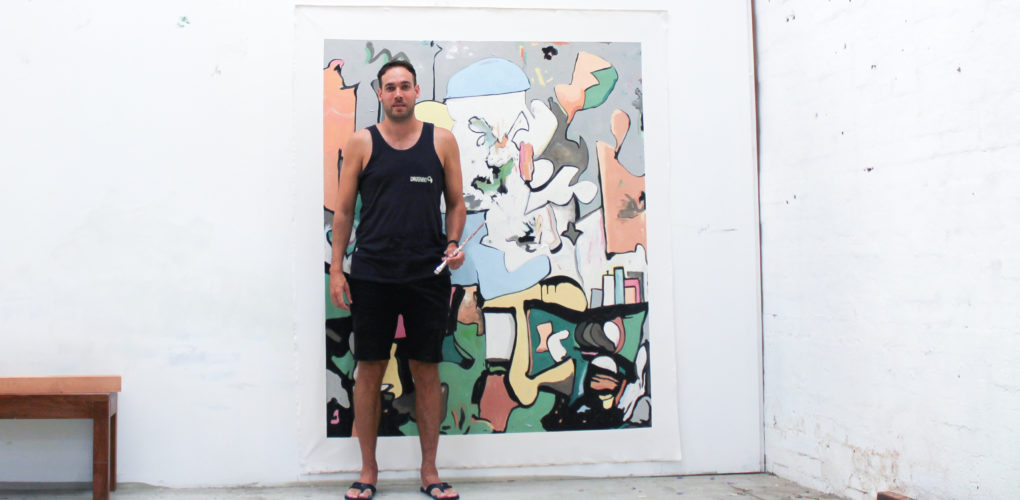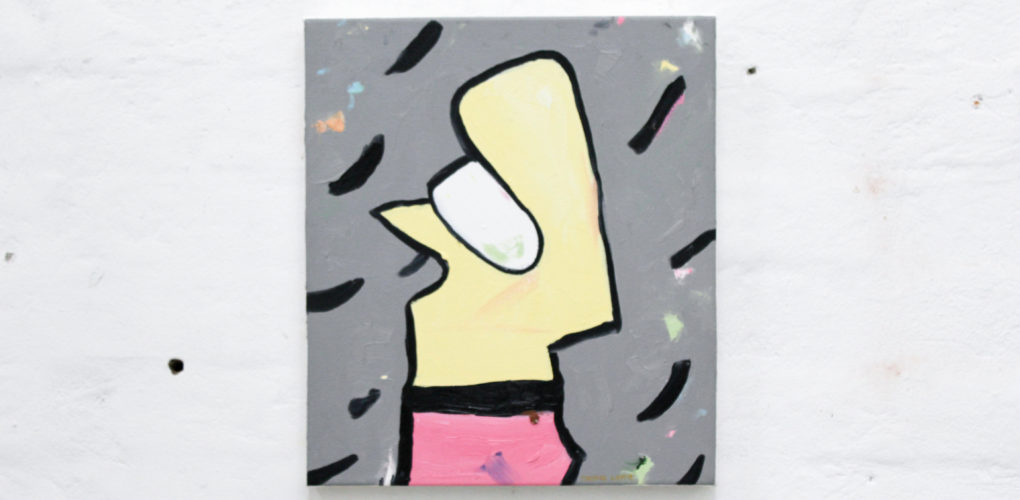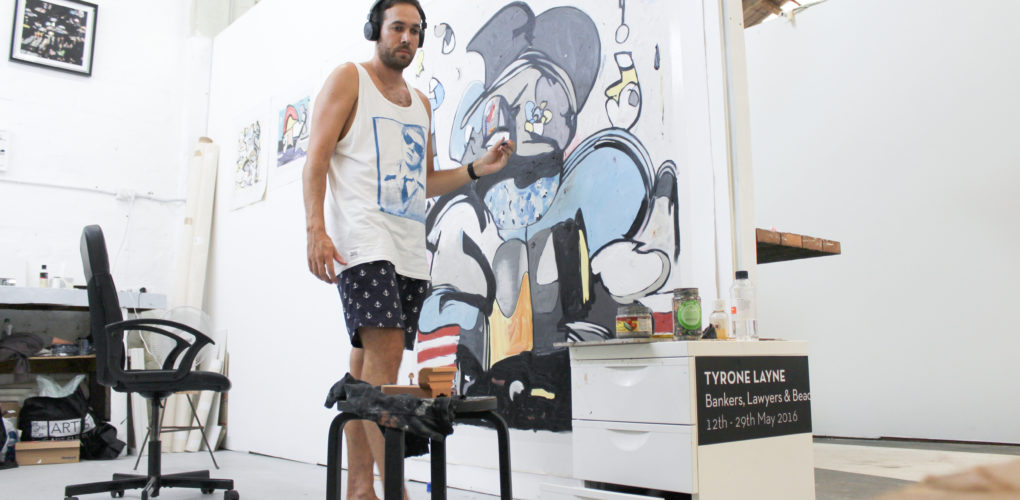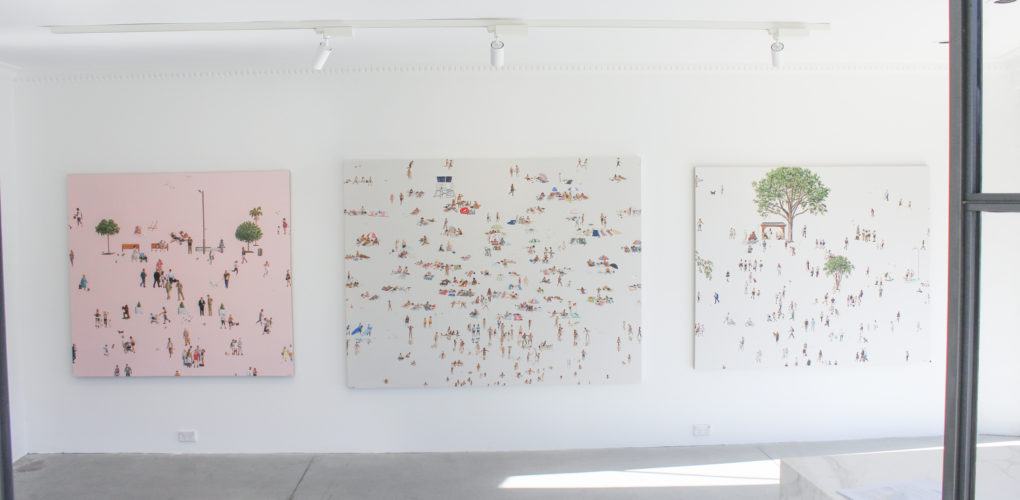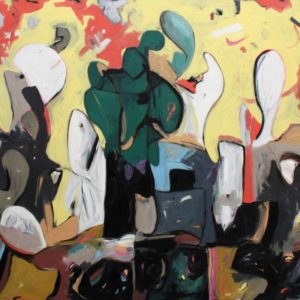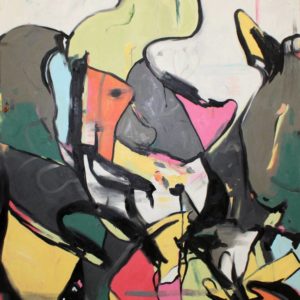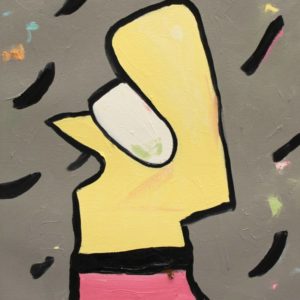One to Watch
 Tyrone Layne’s Freedom of Expression
Tyrone Layne’s Freedom of Expression
Tyrone Layne’s paintings offer freedom of expression. Inspired by the rhythm and action painting of the New York school of abstract expressionism, he experiments with color, forms, and bold brush strokes on a large scale. These works mark a recent departure from his Peoplescape series — which depicts small, photorealistic figures on a flat background– but he still incorporates figurative and landscape elements. For Tyrone, the spontaneous nature of these works allows him to create something new, playful, and indicative of the uncertainty of modern times.
Tyrone was born in New Zealand and now lives and works in Sydney. He received a BFA in Painting from UNITEC, Auckland. He has had numerous solo and group shows in the US, UK, Australia, New Zealand and has exhibited his works at The Other Art Fair in Los Angeles, Melbourne, and Sydney.
What are the major themes you pursue in your work?
My new series of large scale oil paintings have had a big shift from realistic figurative works into abstract work. Through different formed shapes and black line, I create a composition which can have aspects of landscapes, figures, and objects. I like to think of them as dreamscapes in an alternate universe. Different color palettes help create a different mood for the viewer. The works create a push-pull effect, with certain forms and colors jumping forward, while other more subtle colors and tone changes take place in the background. I exhibited these works for the first time at The Other Art Fair in Los Angeles.
How did you first get interested in your medium, and what draws you to it specifically?
I’ve been painting with oil paint for the past 13 years. Once I made the change from acrylic, I never looked back. I like the slower drying times, as it allows for easier blending of colors. I also love that every color and brand has a different quality or texture out of the tube. I tend to try different brands out, but probably Williamsburg is my favorite, as most colors I’ve tried have a very strong tinting quality.
How has your style and practice changed over the years?
This body of abstract work I started 6 months ago is a big change to what I had been painting for the past 10 years. For the last 3 years, I’ve been exhibiting Peoplescape paintings, which have small figures realistically painted over a flat background colour which was often an off-white. These scenes would be mainly at the beach or in an urban setting. I still will be producing the peoplescapes, with my first New York solo show lined up for August.
I have moved into abstraction as I’m now in my early thirties and my art tastes have changed over the years as my knowledge of contemporary art has grown. I’m loving working with much freer brushstrokes to create something which is new, playful, and challenging to me.
Can you walk us through your process? Do you begin with a sketch, or do you just jump in? How long do you spend on one work? How do you know when it is finished?
I start each painting with a loose drawing using a fluid black acrylic similar to an ink. This is how I quickly whip up the composition with an automatic drawing process, where I’ll instinctively paint shapes and line to construct a balanced composition.
I then will start painting with oils, using mainly an inch thick paint brush. The main colors of the painting will be thought out before starting, but with freedom to change the original palette as the painting progresses.
I’ll normally finish one of these paintings within 2 days of starting. Luckily I’m able to paint full time 9am-5pm Monday-Friday, so it allows me to have full days in the studio to make good progress. I have a good idea when a painting is finished. I like to do it in one hit to avoid overworking an image, although sometimes looking back on a work from a few weeks ago, I see that it may need something added or taken away.
Who are some of your favorite artists, and why?
Anselm Kiefer is an amazing artist I admire. He has done incredible things in his career, pushing the limits on scale and what is possible more than most painters and sculptors ever have. I love the texture and history he builds up on his very large scale canvases. I was able to catch his solo show at Gagosian Gallery in New York last year.
Eddie Martinez is also one of my favorite artists. I loved his move into abstraction, with the looseness and energy his paintings have. The New York based artist is much younger than Kiefer, with a bright future ahead. He currently has 2 solo shows opened at Mitchell-Innes & Nash Gallery in New York.
What are some of your favorite experiences as an artist?
Being able to travel and set up studio temporarily in a different country has definitely been my career highlight. In 2016 I moved over to Bushwick- Brooklyn for the month of July in order to paint a large commission work. A year later I returned for 6 weeks to do another commission, this time staying in Manhattan. I could see my commission from the previous year enlarged covering the entire café wall down the road from Times Square for the first time.
